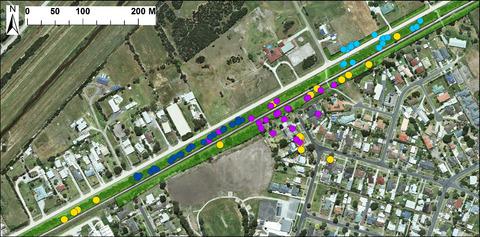当前位置:
X-MOL 学术
›
Anim. Conserv.
›
论文详情
Our official English website, www.x-mol.net, welcomes your feedback! (Note: you will need to create a separate account there.)
Life in linear habitats: the movement ecology of an endangered mammal in a peri‐urban landscape
Animal Conservation ( IF 3.4 ) Pub Date : 2019-08-31 , DOI: 10.1111/acv.12533 S. J. Maclagan 1 , T. Coates 2 , B. A. Hradsky 3 , R. Butryn 4 , E. G. Ritchie 1
Animal Conservation ( IF 3.4 ) Pub Date : 2019-08-31 , DOI: 10.1111/acv.12533 S. J. Maclagan 1 , T. Coates 2 , B. A. Hradsky 3 , R. Butryn 4 , E. G. Ritchie 1
Affiliation

|
Animal movement can be significantly altered in human‐dominated landscapes such as urban and peri‐urban areas, where habitat is often fragmented and/or linear. Knowledge regarding how wildlife respond to anthropogenic change is vital for informing conservation efforts in such landscapes, including the design of nature reserves and wildlife corridors. To better understand how threatened species persist and behave within human‐dominated landscapes, we examined the home range and space use of the nationally endangered southern brown bandicoot Isoodon obesulus obesulus in peri‐urban Melbourne, Australia’s second‐largest city. Specifically, we examined whether: (1) bandicoots were confined to linear strips of remnant vegetation or also made use of the broader highly modified landscape matrix; (2) the configuration of the linear vegetated strips affected home range shape; and (3) home range area differed between bandicoots living in linear strips and those in larger remnant habitat patches. We found that: (1) 71% of adult males and 33% of adult females used the matrix, but non‐dispersing juveniles were entirely confined to the linear strips; males also travelled greater distances into the matrix (away from the vegetated strips) than females; (2) bandicoots had longer home ranges in narrower strips and males had longer home ranges than females; and (3) home range area for both sexes was smaller in linear strips than has been recorded in other studies in larger remnant habitats. Our study highlights the importance of retaining narrow, fragmented and modified vegetation to accommodate threatened biodiversity within human‐dominated landscapes, but suggests the surrounding matrix may also offer important resources for adaptable species, such as bandicoots. Supporting off‐reserve conservation of biodiversity in novel ecosystems is increasingly pertinent in our rapidly urbanizing world.
中文翻译:

线性栖息地中的生命:城市周边景观中濒危哺乳动物的运动生态学
在人类主导的景观中,动物的运动会发生显着变化,例如城市和城郊地区,这些地区的栖息地通常是分散的和/或线性的。关于野生动物如何应对人为变化的知识对于为此类景观的保护工作提供信息至关重要,包括自然保护区和野生动物走廊的设计。为了更好地了解受威胁物种如何在人类主导的景观中生存和行为,我们研究了澳大利亚第二大城市墨尔本郊区的全国濒临灭绝的南部棕袋狸 Isoodon obesulus obesulus 的栖息地和空间使用情况。具体来说,我们检查了:(1)袋狸是否被限制在残余植被的线性条带上,或者是否也利用了更广泛的高度修改的景观矩阵;(2)线状植被带的配置影响了家畜范围的形状;(3) 生活在线性条带中的袋狸和较大的残留栖息地斑块中的袋狸的栖息地面积不同。我们发现: (1) 71% 的成年雄性和 33% 的成年雌性使用基质,但不分散的幼鱼完全被限制在线性条带中;雄性也比雌性更远地进入基质(远离植被带);(2)袋狸在较窄的条带上有更长的活动范围,而雄性的活动范围比雌性长;(3) 线性条带中两性的栖息地面积小于其他研究中记录的较大残余栖息地。我们的研究强调了保持狭窄的重要性,破碎和改造的植被以适应人类主导的景观中受威胁的生物多样性,但表明周围的基质也可能为适应性强的物种提供重要的资源,如袋狸。在我们快速城市化的世界中,支持新生态系统中生物多样性的保护区外保护越来越重要。
更新日期:2019-08-31
中文翻译:

线性栖息地中的生命:城市周边景观中濒危哺乳动物的运动生态学
在人类主导的景观中,动物的运动会发生显着变化,例如城市和城郊地区,这些地区的栖息地通常是分散的和/或线性的。关于野生动物如何应对人为变化的知识对于为此类景观的保护工作提供信息至关重要,包括自然保护区和野生动物走廊的设计。为了更好地了解受威胁物种如何在人类主导的景观中生存和行为,我们研究了澳大利亚第二大城市墨尔本郊区的全国濒临灭绝的南部棕袋狸 Isoodon obesulus obesulus 的栖息地和空间使用情况。具体来说,我们检查了:(1)袋狸是否被限制在残余植被的线性条带上,或者是否也利用了更广泛的高度修改的景观矩阵;(2)线状植被带的配置影响了家畜范围的形状;(3) 生活在线性条带中的袋狸和较大的残留栖息地斑块中的袋狸的栖息地面积不同。我们发现: (1) 71% 的成年雄性和 33% 的成年雌性使用基质,但不分散的幼鱼完全被限制在线性条带中;雄性也比雌性更远地进入基质(远离植被带);(2)袋狸在较窄的条带上有更长的活动范围,而雄性的活动范围比雌性长;(3) 线性条带中两性的栖息地面积小于其他研究中记录的较大残余栖息地。我们的研究强调了保持狭窄的重要性,破碎和改造的植被以适应人类主导的景观中受威胁的生物多样性,但表明周围的基质也可能为适应性强的物种提供重要的资源,如袋狸。在我们快速城市化的世界中,支持新生态系统中生物多样性的保护区外保护越来越重要。


























 京公网安备 11010802027423号
京公网安备 11010802027423号